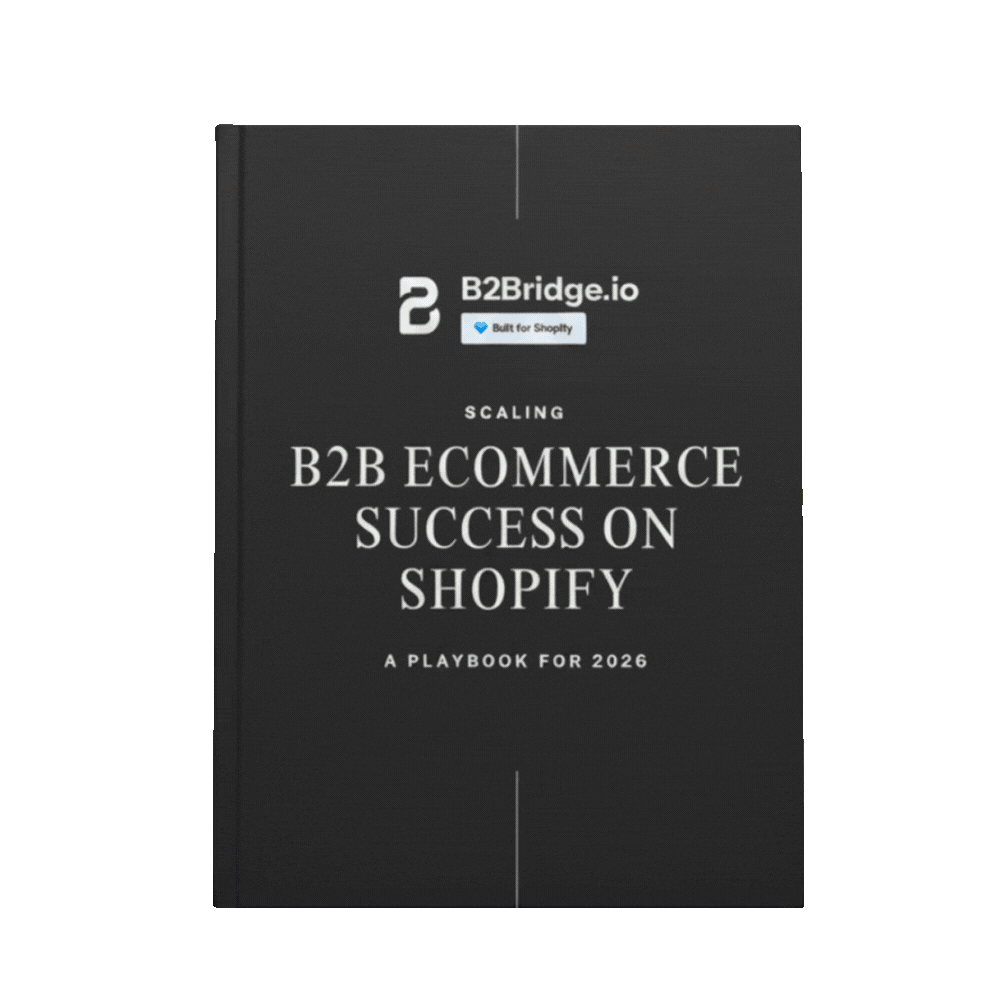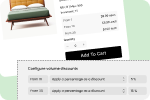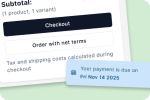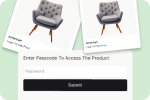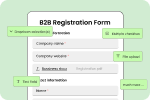The B2B Ecommerce landscape is transforming rapidly, and 2026 promises to be a watershed year for wholesale digital commerce. For Shopify merchants, this evolution presents both opportunity and challenge.
The opportunity? B2B Ecommerce is projected to account for 17% of all B2B sales in the US by 2027, representing billions in accessible revenue. The challenge? Meeting escalating buyer expectations while managing the operational complexities inherent to wholesale commerce.
In this comprehensive guide, we’ll explore the essential strategies for Shopify B2B set up success, covering everything from user experience design to payment customization, self-service features, and future-proofing tactics.

Understanding the Modern B2B Buyer
B2B buyers increasingly expect the same seamless experiences they enjoy as consumers, while simultaneously demanding sophisticated functionality that reflects the complexity of business purchasing.
Learning Shopify B2B set up for B2B success in 2026 and beyond requires more than basic wholesale functionality – it demands a strategic approach that balances user-friendly design with powerful business features. Your B2B platform must feel as intuitive as Amazon while handling custom pricing, multi-location accounts, approval workflows, and complex ordering processes.
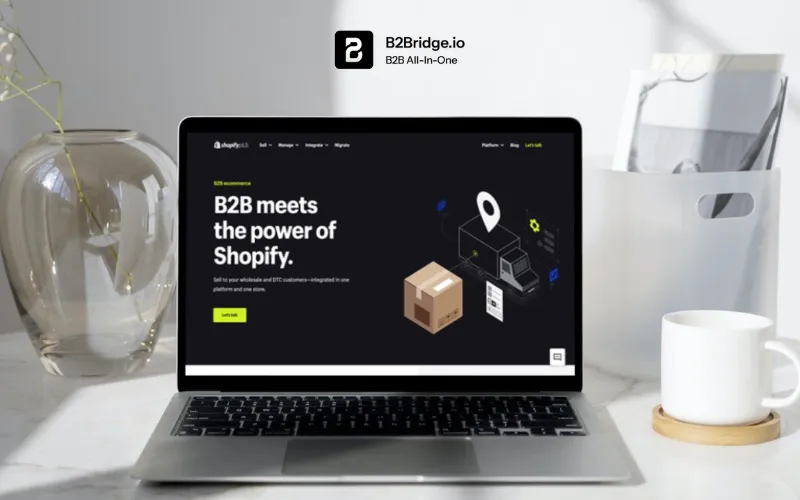
The good news? Shopify’s ecosystem, enhanced by specialized B2B solutions like B2Bridge, provides everything you need to build a world-class wholesale channel. But success requires understanding what modern B2B buyers expect and implementing best practices that address their unique needs.
How B2B Buyer Expectations Have Evolved
Today’s wholesale buyers are fundamentally different from those of even five years ago. They’re digital natives who make personal purchases on their phones and expect the same convenience in their professional lives.
Key shifts in B2B buyer behavior:
Self-service preference: 73% of B2B buyers prefer to research and purchase independently rather than interact with sales representatives. They want information at their fingertips, not gatekept behind sales calls.
Mobile-first mentality: Over 60% of B2B buyers now research products on mobile devices. Your Shopify B2B store must deliver full functionality across all screen sizes.
Speed expectations: B2B buyers expect instant access to pricing, inventory availability, and order tracking. Delays that were acceptable in the era of phone-based ordering are now deal-breakers.
Experience parity: Wholesale customers want D2C-quality experiences – fast load times, intuitive navigation, and personalized recommendations – while accessing B2B-specific features.
Transform your B2B store with B2Bridge.
Discover how B2Bridge can transform your wholesale business.
Schedule a demo today to see our payment management tools in action.
Critical Differences Between D2C and B2B
While experience expectations align, fundamental differences between retail and wholesale persist:
Sales cycles: D2C purchases happen in minutes; B2B decisions can take weeks or months involving multiple stakeholders and approval layers.
Order complexity: Retail orders average 1-3 items; wholesale orders may include hundreds of SKUs with specific configurations and delivery requirements.
Financial arrangements: Consumers pay immediately; B2B buyers expect net terms, purchase orders, and credit arrangements.
Account structure: Individual consumers shop independently; wholesale accounts often have multiple users, locations, and permission levels.
Risk profile: A $50 retail mistake is negligible; a $50,000 wholesale error has serious business consequences.
Your Shopify B2B set up must acknowledge these differences while delivering the streamlined experience modern buyers demand.
1. Design a D2C-Quality Experience with B2B Power
The UX Balancing Act
The most successful Shopify B2B set up stores don’t feel like wholesale portals – they feel like premium consumer experiences that happen to include sophisticated business features.
Focus on these foundational UX principles:
Intuitive navigation: Organize products logically with clear categories, robust search, and smart filtering. B2B buyers shouldn’t need training to find what they want.
Fast performance: Optimize for speed. Every second of load time reduces conversion rates. Compress images, minimize apps, and test performance regularly across devices.
Mobile responsiveness: Don’t just shrink your desktop site – design truly mobile-optimized experiences. B2B buyers research during commutes, order from warehouses, and check inventory on tablets.
Clear information architecture: Present information hierarchically. Most important details (price, availability, minimum quantities) should be immediately visible, with supporting information accessible but not overwhelming.
Friction reduction: Identify and eliminate unnecessary steps in the purchase journey. Can customers reorder in two clicks? Can they find technical specifications without leaving product pages? Does checkout flow smoothly?
Tailoring Tone for Professional Context
While maintaining D2C-level polish, adjust your communication style for business audiences:
Professional but personable: Strike a balance between corporate formality and approachability. “Let’s grow your business together” resonates better than “Hey friend!”
Clarity over cleverness: B2B buyers value straightforward communication. Save creative copywriting for brand storytelling; use plain language for transactional content.
Value-focused messaging: Emphasize ROI, efficiency gains, and business outcomes rather than emotional benefits.
Industry-appropriate language: Use terminology your wholesale customers understand and expect, demonstrating that you know their business.
B2Bridge enables you to maintain separate storefronts with distinct branding and messaging for B2C and B2B audiences, ensuring each customer type receives appropriate communication.
2. Implement Flexible Payment Terms and Pricing
Beyond Standard Payment Options
One-size-fits-all payment doesn’t work in B2B. Different customer segments require different financial arrangements based on relationship maturity, order volume, and creditworthiness.
Custom payment terms your Shopify B2B store should support:
Net terms: Net 30, Net 60, and Net 90 payment deadlines for established accounts with approved credit
Purchase orders: Formal PO workflows for enterprise customers with procurement departments
Credit limits: Customer-specific credit ceilings that prevent overextension
Deposit requirements: Partial upfront payment for new customers or large custom orders
Staged payments: Payment schedules tied to project milestones for complex orders
Customer-Specific Pricing Structures
Generic pricing frustrates wholesale buyers who expect rates reflecting their relationship value and order volume.
Implement tiered pricing strategies:
Volume-based tiers: Automatic discounts that apply when customers reach quantity thresholds (30% off for 50+ units, 40% off for 100+ units)
Customer segment pricing: Different base rates for retailers, distributors, and enterprise accounts based on their role in your supply chain
Contract pricing: Negotiated rates for high-value accounts locked in for specific periods
Geographic pricing: Regional pricing variations reflecting local market conditions or shipping considerations
Product category pricing: Different margin structures for various product lines

B2Bridge makes customer-specific pricing straightforward, automatically displaying appropriate rates when customers log in. No manual quote generation, no pricing confusion – just personalized rates ready for ordering.
Credit Management
As you extend payment terms, implement robust credit controls:
- Credit application processes with trade reference verification
- Integration with credit reporting agencies for risk assessment
- Automated credit limit enforcement preventing over-extension
- Account holds for customers with overdue balances
- Regular credit reviews adjusting limits based on payment history
3. Create Personalized Customer Dashboards
Account Pages That Work
Generic account pages waste opportunity. Your wholesale customers should log in to a dashboard designed specifically for their needs, showing relevant information and enabling efficient action.
Essential dashboard elements:
Order history with smart filtering: Search by date range, product, order value, or location. Enable customers to find specific past orders instantly.
One-click reordering: Display recent orders with prominent “Buy Again” buttons. Routine reorders should take seconds, not minutes.
Account-specific information: Show negotiated pricing, available credit, pending approvals, and payment terms prominently.
Multi-location management: For customers with multiple branches, enable location-based filtering and ordering with location-specific visibility.
Document library: Provide access to invoices, packing slips, product catalogs, spec sheets, and marketing materials in one organized location.
Quick order entry: Include SKU-based quick order forms directly on the dashboard for efficient bulk ordering.
Team and Permission Management
Modern B2B accounts involve multiple stakeholders with different roles and access needs. B2Bridge’s team functionality enables sophisticated permission management:
Role-based access: Create user types like “purchaser,” “approver,” “viewer,” and “admin” with appropriate permissions for each
Location restrictions: Limit users to viewing and ordering only for their assigned locations
Approval workflows: Require manager approval for orders exceeding defined thresholds
Product catalog visibility: Show different product subsets to different user types (e.g., technicians see maintenance supplies, purchasing managers see everything)
Budget controls: Set spending limits per user or location
This granular control makes your wholesale customers feel understood and accommodated, strengthening loyalty while reducing operational friction.
4. Optimize for Effortless Ordering and Reordering
The Reorder Imperative
In B2B commerce, most orders are reorders. Customers aren’t browsing for new products – they’re restocking inventory they’ve purchased before. Making reordering seamless is perhaps the single most impactful UX improvement you can make.
Reorder acceleration strategies:
Instant order duplication: One-click recreation of any previous order with automatic application of current pricing
Saved order templates: Let customers save frequently ordered combinations as templates (e.g., “Weekly Restaurant Supply Order” or “Monthly Office Supplies”)
Smart recommendations: “You usually reorder Product X every 30 days – it’s been 28 days” prompts that anticipate needs
Subscription ordering: Automated recurring shipments for consumable products, reducing manual reordering entirely
Quick lists: Customer-created lists of commonly ordered items accessible for rapid basket building
Bulk Order Functionality
Wholesale orders involve quantity. Your product pages must accommodate bulk ordering efficiently:
Quantity selectors: Dropdowns or input fields with increment controls (case quantities, pallet quantities) rather than single-unit +/- buttons
Minimum order quantities: Clear display and enforcement of MOQs at the product level
Pack size indicators: Show how products are packaged (sold by the case of 24, pallet of 500, etc.)
Bulk import: CSV upload functionality for customers ordering from spreadsheets or ERP exports
Multi-product selection: Ability to add multiple items to cart simultaneously rather than one-by-one
Draft Orders and Assisted Ordering
Not every order originates from self-service. Enable your team to support customers through B2Bridge’s draft order capabilities:
- Sales reps can build baskets on behalf of customers during phone consultations
- Create custom orders with special pricing or configurations
- Send draft orders to customers for review and approval before processing
- Convert email or phone orders into digital format seamlessly
This hybrid approach accommodates diverse customer preferences while maintaining digital efficiency.
5. Enhance Product Pages for Confident Decision-Making
Information Depth for High-Stakes Purchases
B2B buyers make expensive, business-critical purchasing decisions. They need comprehensive product information to buy confidently without contacting sales.
Essential product page elements:
Technical specifications: Detailed dimensions, materials, tolerances, certifications, and compatibility information
Downloadable resources: Product sheets, installation guides, safety data sheets (SDS), certifications, and user manuals available for immediate download
High-quality imagery: Multiple angles, lifestyle photos, dimensional drawings, and where appropriate, 360-degree views or video demonstrations
Inventory visibility: Real-time stock levels and lead times if out of stock. B2B buyers need to know if products are available now or require waiting.
Related products: Cross-sells and complementary items that might be needed (e.g., showing mounting hardware with equipment)
Application examples: Use cases showing how other businesses apply the product
Bulk pricing display: Clear visibility of volume discounts and tier breaks
Building Purchase Confidence
Reduce pre-purchase anxiety with trust signals:
- Customer reviews and testimonials from business buyers
- Case studies showing successful implementation
- Industry certifications and compliance information
- Warranty and return policy details
- Customer support contact readily available
Remember that B2B purchases often require approval from multiple stakeholders. Your product pages must provide all the information a buyer needs to make their internal case for the purchase.
6. Enable Comprehensive Self-Service
Reducing Sales Team Dependency
The most scalable B2B operations empower customers to find answers and complete transactions independently. This doesn’t eliminate human support – it reserves it for high-value consultative interactions rather than routine questions.
Self-service essentials:
Knowledge base: Searchable help center addressing common wholesale-specific questions:
- How to place orders and track shipments
- Understanding pricing and payment terms
- Product selection and specification guidance
- Return and warranty procedures
- Account management instructions
Video tutorials: Short how-to videos demonstrating key platform features and ordering processes
Product comparison tools: Enable customers to evaluate multiple products side-by-side based on specifications and pricing
Order tracking: Real-time visibility into order status, shipment tracking, and delivery confirmation without needing to call customer service
Account management: Customer-controlled profile updates, user management, and billing information changes
FAQ sections: Both general B2B FAQs and product-specific questions addressing selection criteria and application guidance
Intelligent Chatbots and Escalation
Implement AI-powered chat that handles routine queries while smoothly escalating complex issues:
- Answer frequently asked questions instantly
- Guide customers through product selection based on requirements
- Provide order status and tracking information
- Direct to appropriate help articles
- Connect to human support when needed
Modern chatbots are sophisticated enough to resolve 60-70% of queries without human intervention, dramatically improving response times while reducing support costs.
Resource Libraries
Create dedicated sections for downloadable assets:
Marketing materials: Product catalogs, line cards, and marketing collateral your wholesale customers can use with their own customers
Training resources: Installation videos, maintenance guides, and best practice documentation
Compliance documentation: Certifications, test reports, and regulatory compliance documents required for various industries
Pricing sheets: Current price lists in downloadable format for offline reference
-> Give free wholesale pricing sheet templates for free
7. Future-Proof Your B2B Platform
Emerging Trends to Embrace
As you set up your Shopify store for B2B success in 2026, anticipate these evolving trends:
AI-powered personalization: Machine learning algorithms that predict reorder timing, recommend products based on purchasing patterns, and optimize pricing dynamically
Voice commerce: Integration with voice assistants for hands-free reordering (“Alexa, reorder my standard monthly supplies”)
Augmented reality: AR product visualization helping B2B buyers see how products fit in their facilities before purchasing
Blockchain-based supply chain transparency: Immutable tracking of product authenticity, origin, and handling throughout supply chains
Sustainability reporting: Carbon footprint tracking and sustainability metrics becoming standard purchase criteria
Advanced analytics: Sophisticated reporting showing customers their purchasing patterns, optimization opportunities, and spending analytics
Building for Flexibility
Technology evolves rapidly. Design your B2B infrastructure for adaptability:
API-first architecture: Choose solutions with robust APIs enabling future integrations
Modular approach: Implement features incrementally rather than massive all-at-once launches
Regular platform reviews: Quarterly assessments of new Shopify features and B2B ecosystem developments
Customer feedback loops: Ongoing input collection from wholesale buyers about desired features
Scalability considerations: Ensure your setup handles growth without requiring complete rebuilds
B2Bridge continuously evolves with new features and integrations, ensuring your wholesale platform stays current without requiring migration to new systems.
Key Performance Indicators to measure B2B Success for 2026
Track these metrics to gauge your Shopify B2B performance:
Adoption rate: Percentage of wholesale customers actively using your B2B platform vs. traditional ordering methods
Digital order penetration: What proportion of total wholesale revenue flows through your Shopify store?
Self-service rate: Percentage of orders placed without sales rep assistance
Average order value: Are B2B orders meeting or exceeding targets?
Reorder frequency: How often do customers return to place subsequent orders?
Mobile conversion rate: What percentage of mobile visitors complete purchases?
Customer satisfaction (CSAT): Regular surveys measuring B2B customer experience satisfaction
Platform engagement: Time spent on site, pages viewed, feature utilization
Conclusion
Shopify B2B set up for B2B success in 2026 and beyond requires balancing sophisticated business functionality with the seamless user experience modern buyers expect. Your wholesale customers want the convenience of consumer commerce combined with the power tools necessary for complex business purchasing.
The future of B2B Ecommerce favors merchants who respect their buyers’ intelligence, value their time, and provide tools that make business purchasing genuinely easier. Build that experience, and success in 2026 and beyond will follow.
Ready to Build Your B2B Future on Shopify?
B2Bridge transforms your Shopify store into a complete B2B powerhouse with all the features modern wholesale buyers expect. From custom pricing and flexible payment terms to personalized dashboards and advanced reordering capabilities, B2Bridge delivers enterprise-grade B2B functionality without enterprise complexity.
Our platform grows with your business, continuously adding features that keep you ahead of evolving buyer expectations. Whether you’re launching your first wholesale channel or upgrading from legacy B2B systems, B2Bridge provides the foundation for sustainable growth.
Explore B2Bridge Features | Schedule a Demo | Start Free Trial
Planning your B2B strategy for 2026? Our Ecommerce specialists can help you design a wholesale solution perfectly matched to your business requirements and growth objectives. Contact us to discuss your vision for B2B success.
Hi, I’m Ha My Phan – an ever-curious digital marketer crafting growth strategies for Shopify apps since 2018. I blend language, logic, and user insight to make things convert. Strategy is my second nature. Learning is my habit. And building things that actually work for people? That’s my favorite kind of win.
